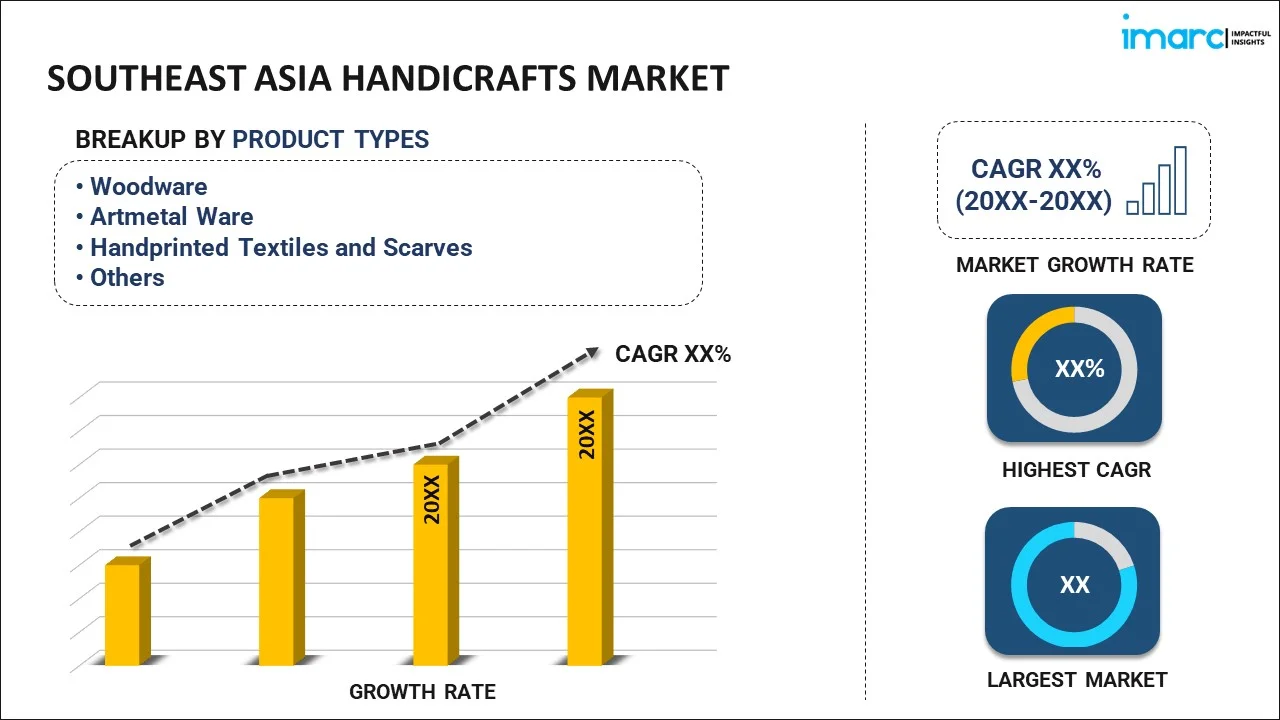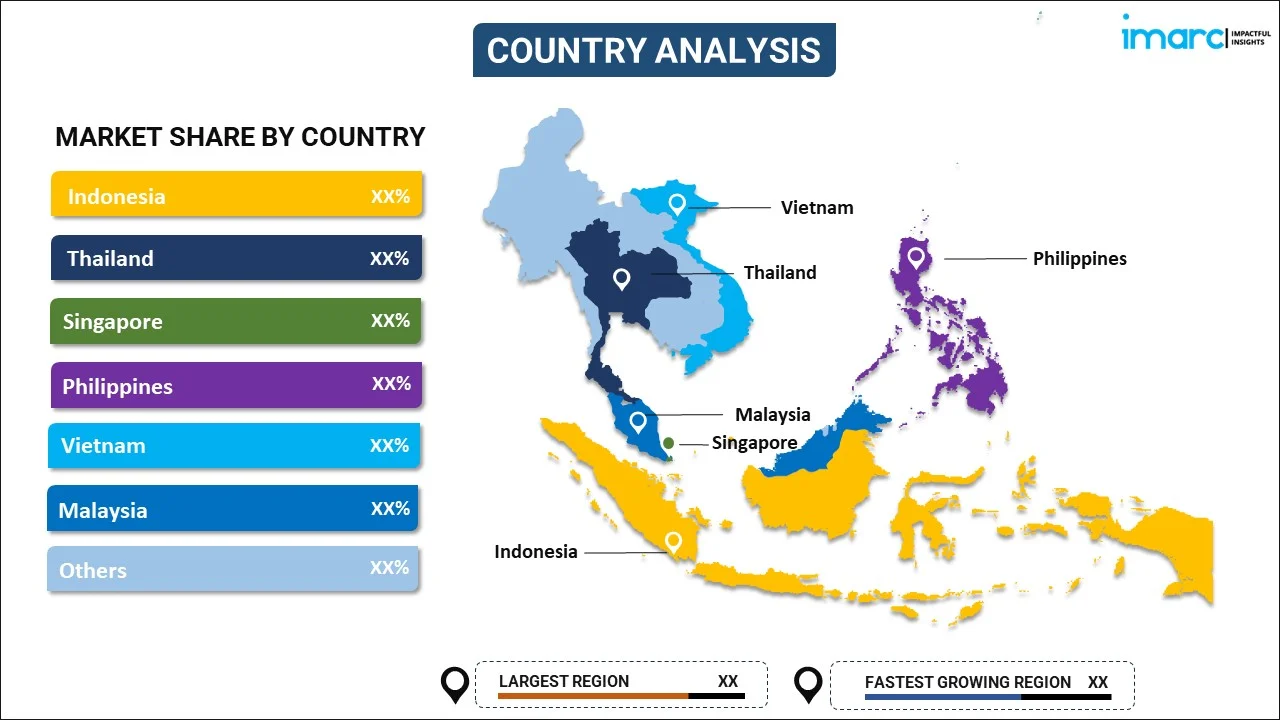
Southeast Asia Handicrafts Market Report by Product Type (Woodware, Artmetal Ware, Handprinted Textiles and Scarves, Embroidered and Crocheted Goods, Zari and Zari Goods, Imitation Jewellery, Sculptures, Pottery and Glass wares, Attars and Agarbattis, and Others), Distribution Channel (Mass Retailers, Departmental Stores, Independent Retailers, Specialty Stores, Online Stores, and Others), End Use (Residential, Commercial), and Country 2024-2032
Market Overview:
Southeast Asia handicrafts market size is projected to exhibit a growth rate (CAGR) of 6.70% during 2024-2032. The increasing focus on emphasis on sustainability, along with the growing number of export activities, is primarily driving the market growth.
|
Report Attribute
|
Key Statistics
|
|---|---|
|
Base Year
|
2023 |
|
Forecast Years
|
2024-2032
|
|
Historical Years
|
2018-2023
|
| Market Growth Rate (2024-2032) | 6.70% |
Handicrafts represent artisanal products meticulously crafted by hand, excluding the use of automated machinery and often employing traditional methods. This category encompasses a diverse range of items, including textiles, pottery, jewelry, and woodwork. These creations are meticulously shaped using an assortment of natural and synthetic materials, such as wood, clay, fibers, plastic, and metal. Handicrafts find extensive application in home decor, fashion accessories, toys, furniture, religious ceremonies, and the realm of gift-giving. They also play a significant role in the preservation of cultural heritage, serve as educational tools, foster community cohesion, and facilitate artisanal training. These distinctive and environmentally friendly products serve to empower artisans, safeguard cultural legacy, and contribute to poverty reduction.
Southeast Asia Handicrafts Market Trends:
The Southeast Asia handicrafts market is predominantly stimulated by the escalating influx of international and domestic tourists within the region, fostering a conducive environment for local artisans and craftsmen to produce and market various commoditized handicraft products. Additionally, prominent handicraft enterprises are ramping up their export activities, encompassing a diverse array of handlooms, carpets, textiles, and garments, thereby fortifying the overall market growth in the region. These companies are also actively engaged in providing comprehensive training in design and production techniques to local artisans, thereby creating ample market opportunities for the skilled workforce. Furthermore, the rapid expansion of the e-commerce sector, coupled with strategic initiatives undertaken by governmental bodies, is exerting a positive influence on the demand for handicraft products. Notably, the introduction of an online platform aimed at promoting the sales of handicrafts by offering detailed product descriptions and highlighting the artisans behind the creations, thus contributing to the growth and visibility of the handicrafts market in the region. Besides this, the growing emphasis on environmental awareness is emerging as a prominent factor influencing consumer choices across multiple industries. Handicrafts typically leave a smaller environmental impact compared to mass-manufactured goods, primarily attributed to their localized production and the frequent utilization of natural, biodegradable materials, which is expected to propel the market growth over the forecasted period.
Southeast Asia Handicrafts Market Segmentation:
IMARC Group provides an analysis of the key trends in each segment of the market, along with forecasts at the regional and country levels for 2024-2032. Our report has categorized the market based on product type, distribution channel, and end use.
Product Type Insights:

- Woodware
- Artmetal Ware
- Handprinted Textiles and Scarves
- Embroidered and Crocheted Goods
- Zari and Zari Goods
- Imitation Jewellery
- Sculptures
- Pottery and Glass wares
- Attars and Agarbattis
- Others
The report has provided a detailed breakup and analysis of the market based on the product type. This includes woodware, artmetal ware, handprinted textiles and scarves, embroidered and crocheted goods, zari and zari goods, imitation jewellery, sculptures, pottery and glass wares, attars and agarbattis, and others.
Distribution Channel Insights:
- Mass Retailers
- Departmental Stores
- Independent Retailers
- Specialty Stores
- Online Stores
- Others
A detailed breakup and analysis of the market based on the distribution channel have also been provided in the report. This includes mass retailers, departmental stores, independent retailers, specialty stores, online stores, and others.
End Use Insights:
- Residential
- Commercial
The report has provided a detailed breakup and analysis of the market based on the end use. This includes residential and commercial.
Country Insights:

- Indonesia
- Thailand
- Singapore
- Philippines
- Vietnam
- Malaysia
- Others
The report has also provided a comprehensive analysis of all the major regional markets, which include Indonesia, Thailand, Singapore, Philippines, Vietnam, Malaysia, and Others.
Competitive Landscape:
The market research report has also provided a comprehensive analysis of the competitive landscape in the market. Competitive analysis such as market structure, key player positioning, top winning strategies, competitive dashboard, and company evaluation quadrant has been covered in the report. Also, detailed profiles of all major companies have been provided.
Southeast Asia Handicrafts Market Report Coverage:
| Report Features | Details |
|---|---|
| Base Year of the Analysis | 2023 |
| Historical Period | 2018-2023 |
| Forecast Period | 2024-2032 |
| Units | US$ Billion |
| Scope of the Report | Exploration of Historical and Forecast Trends, Industry Catalysts and Challenges, Segment-Wise Historical and Predictive Market Assessment:
|
| Product Types Covered | Woodware, Artmetal Ware, Handprinted Textiles and Scarves, Embroidered and Crocheted Goods, Zari and Zari Goods, Imitation Jewellery, Sculptures, Pottery and Glass wares, Attars and Agarbattis, Others |
| Distribution Channels Covered | Mass Retailers, Departmental Stores, Independent Retailers, Specialty Stores, Online Stores, Others |
| End Uses Covered | Residential, Commercial |
| Countries Covered | Indonesia, Thailand, Singapore, Philippines, Vietnam, Malaysia, Others |
| Customization Scope | 10% Free Customization |
| Report Price and Purchase Option | Single User License: US$ 3699 Five User License: US$ 4699 Corporate License: US$ 5699 |
| Post-Sale Analyst Support | 10-12 Weeks |
| Delivery Format | PDF and Excel through Email (We can also provide the editable version of the report in PPT/Word format on special request) |
Key Questions Answered in This Report:
- How has the Southeast Asia handicrafts market performed so far and how will it perform in the coming years?
- What has been the impact of COVID-19 on the Southeast Asia handicrafts market?
- What is the breakup of the Southeast Asia handicrafts market on the basis of product type?
- What is the breakup of the Southeast Asia handicrafts market on the basis of distribution channel?
- What is the breakup of the Southeast Asia handicrafts market on the basis of end use?
- What are the various stages in the value chain of the Southeast Asia handicrafts market?
- What are the key driving factors and challenges in the Southeast Asia handicrafts?
- What is the structure of the Southeast Asia handicrafts market and who are the key players?
- What is the degree of competition in the Southeast Asia handicrafts market?
Key Benefits for Stakeholders:
- IMARC’s industry report offers a comprehensive quantitative analysis of various market segments, historical and current market trends, market forecasts, and dynamics of the Southeast Asia handicrafts market from 2018-2032.
- The research report provides the latest information on the market drivers, challenges, and opportunities in the Southeast Asia handicrafts market.
- Porter's five forces analysis assist stakeholders in assessing the impact of new entrants, competitive rivalry, supplier power, buyer power, and the threat of substitution. It helps stakeholders to analyze the level of competition within the Southeast Asia handicrafts industry and its attractiveness.
- Competitive landscape allows stakeholders to understand their competitive environment and provides an insight into the current positions of key players in the market.
Need more help?
- Speak to our experienced analysts for insights on the current market scenarios.
- Include additional segments and countries to customize the report as per your requirement.
- Gain an unparalleled competitive advantage in your domain by understanding how to utilize the report and positively impacting your operations and revenue.
- For further assistance, please connect with our analysts.
 Inquire Before Buying
Inquire Before Buying
 Speak to an Analyst
Speak to an Analyst
 Request Brochure
Request Brochure
 Request Customization
Request Customization




.webp)




.webp)












